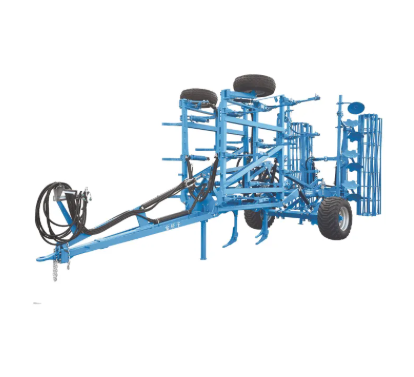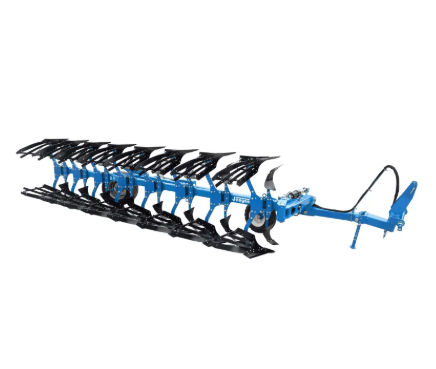Pagbabago ng Modernong Agrikultura sa Pamamagitan ng mga Advanced na Solusyon sa Pagplow
Nagkakaroon ng kamangha-manghang pagbabago ang agrikultural na larawan habang pamungkal na maibabalik patuloy na binabaligtad ng teknolohiya ang mga kasanayan sa pagsasaka sa buong mundo. Mula sa pinahusay na pag-iingat ng lupa hanggang sa pagpapabuti ng ani, binabago ng mga inobatibong implementasyon na ito ang paraan ng mga magsasaka sa paghahanda at pagsasaka sa mga bukid. Pinagsasama ng modernong teknolohiya ng maaaring baligtad na plow ang karunungan ng pagsasaka noong sinaunang panahon at ang makabagong engineering, nag-aalok ng mga solusyon na nakaaapekto pareho sa produktibidad at mga hamon sa mapagkakatiwalaang pagsasaka sa kasalukuyang agrikultura.
Ebolusyon ng Disenyo ng Reversible Plough
Mga Imbentong Mekanikal sa Modernong Sistema ng Plough
Ang paglalakbay ng teknolohiya ng reversible plough ay minarkahan ng makabuluhang mga pag-unlad sa mekanikal na aspeto. Ang mga modernong disenyo ay sumasama sa mga materyales na mataas ang lakas at mga bahagi na may tumpak na disenyo na nagsisiguro ng tibay at pare-parehong pagganap. Ang mga modernong reversible plough ay may mga hydraulic system na nagbibigay-daan sa makinis na operasyon ng pagbabaligtad, binabawasan ang pisikal na pagod sa parehong operator at kagamitan. Ang pagsasama ng mga materyales na nakakatipid sa pagsusuot sa mga kritikal na bahagi ay lubos na pinalawig ang serbisyo ng buhay ng mga implementasyong ito.
Smart Integration and Digital Controls
Ang teknolohiya sa digital ay nagbago sa operasyon ng muling-maaaring plough sa pamamagitan ng sopistikadong mga sistema ng kontrol. Ang mga modernong yunit ay mayroon na ngayong electronic depth control, automated turning sequences, at real-time performance monitoring. Ang mga smart na tampok na ito ay nagpapahintulot sa mga operator na mapanatili ang optimal na lalim ng pagbubungkal at pagkakapareho sa iba't ibang kondisyon ng lupa, na nagreresulta sa mas mahusay na paghahanda ng bukid at nabawasan ang konsumo ng gasolina.

Mga Benepisyong Pangkalikasan at mga Tampok na Nakatuon sa Pagpapanatili
Mga Bentahe sa Pagsalba ng Lupa
Ang kasalukuyang teknolohiya ng muling-maaaring plough ay naglalagay ng matibay na diin sa pangangalaga ng kalusugan ng lupa. Ang mga advanced na disenyo ay minimitahan ang pagkakasikip ng lupa sa pamamagitan ng mas mahusay na distribusyon ng bigat at pinakamainam na pagbuo ng furrow. Ang kakayahan na i-ayos ang mga anggulo at lalim ng pagtatrabaho ay tumutulong sa pagpapanatili ng istraktura ng lupa habang epektibong pinamamahalaan ang pagsasama ng sariwang pananim. Ang mga tampok na ito ay nag-aambag sa pangmatagalang katabaan ng lupa at nabawasan ang panganib ng pagguho.
Mga Pagpapabuti sa Kahusayan ng Pinagkukunan
Ang mga modernong mababagong arado ay isinasama ang mga elemento ng disenyo na makabuluhang binabawasan ang pagkonsumo ng gasolina at mga gastos sa operasyon. Ang mga naibuting hugis ng talim at binawasang kinakailangan sa pagguhit ay nangangahulugan ng mas kaunting lakas ang kailangan para sa epektibong pag-araro. Bukod pa rito, ang mga sistema ng eksaktong kontrol ay tumutulong sa pag-optimize ng mga bilis at lalim ng paggawa, tinitiyak ang mahusay na paggamit ng mga mapagkukunan habang pinapanatili ang mataas na kalidad ng paghahanda ng lupa.
Pagsasama sa Mga Sistema ng Tumpak na Pagsasaka
GPS at mga Automated na Sistema ng Gabay
Ang pagsasama ng teknolohiya ng mababagong arado at mga sistema ng gabay sa GPS ay naglikha ng mga bagong posibilidad para sa tumpak na pagsasaka. Ang mga modernong arado ay maaari nang manatili sa tuwid na linya at mga optimal na pattern ng overlap nang awtomatiko, binabawasan ang pagod ng operator at pinapabuti ang kahusayan ng pagsakop sa bukid. Ang mga sistema ay nagpapahintulot din ng operasyon sa gabi na may parehong antas ng katumpakan ng araw-araw na gawain, nagpapalawig ng produktibong oras sa mahahalagang panahon ng pagtatanim.
Pag-optimize ng Pagganap na Batay sa Data
Ang mga advanced na sensor at monitoring system sa modernong reversible plough ay nagtutugon ng mahalagang datos tungkol sa kondisyon ng lupa, mga depth ng pagtrabaho, at performance ng kagamitan. Nakatutulong ang impormasyong ito sa mga magsasaka na gumawa ng matalinong desisyon tungkol sa mga ploughing pattern, timing, at mga setting ng kagamitan. Ang pagsasama nito sa farm management software ay nagpapahintulot ng masusing pagsusuri at patuloy na pagpapabuti ng mga operasyon sa pagbukid.
Epekto sa Ekonomiya ng Modernong Pagsasaka
Mga Bumalik na Puhunan at Kahusayan sa Operasyon
Kahit ang advanced na teknolohiya ng reversible plough ay nangangahulugan ng isang makabuluhang paunang pamumuhunan, ang matagalang benepisyong pang-ekonomiya ay kahanga-hanga. Ang pinabuting tibay ay nagpapababa sa gastos ng pagpapanatili, samantalang ang pinahusay na kahusayan ay nagreresulta sa mas mababang konsumo ng gasolina at mga pangangailangan sa paggawa. Ang precision at pagkakapareho ng modernong plough ay nag-aambag din sa mas mahusay na paghahanda ng seed bed, na maaaring mapabuti ang ani at kita ng bukid.
Mga Benepisyo sa Pamamahala ng Oras at Paggawa
Ang mga modernong maaaring i-reverse na sistema ng arado ay makabuluhang binabawasan ang oras at pagsisikap na kinakailangan para sa paghahanda ng lote. Ang mga automated na tampok at naaasahang pagganap ay nangangahulugan ng mas kaunting interbensyon ng magsasaka, na nagpapahintulot sa kanila na tumuon sa iba pang mahahalagang gawain. Ang kakayahan ring magtrabaho nang maayos sa iba't ibang kondisyon ng lupa ay nakatutulong din upang i-optimize ang tamang panahon ng pag-aarado sa loob ng maikling panahon ng season.
Mga Paparating na Pag-unlad at Tendensya
Kakayahan ng Autonomong Operasyon
Patungo sa hinaharap, ang teknolohiya ng maaaring i-reverse na arado ay papunta sa ganap na autonomous na operasyon. Ang mga pag-unlad ay nakatuon sa paglikha ng mga self-driving system na maaaring mag-operate nang nakapag-iisa habang pinapanatili ang pinakamahusay na mga parameter ng pag-aarado. Ang mga inobasyong ito ay lalo pang babawasan ang pangangailangan sa tao at magbibigay-daan sa operasyon na 24/7 sa mga kritikal na panahon ng pagsasaka.
Mga Advanced na Materyales at Optimization ng Disenyo
Patuloy ang pananaliksik sa pag-unlad ng mas matibay at magaang mga materyales para sa paggawa ng plow. Ang mga bagong komposit na materyales at advanced na teknik sa pagmamanupaktura ay nangangako na magbibigay ng mga kagamitan na parehong mas matibay at matipid sa enerhiya. Ginagamit na ngayon ang computer-aided design at simulation tools upang i-optimize ang hugis ng talim at mga katangian ng operasyon para sa iba't ibang uri at kondisyon ng lupa.
Mga madalas itanong
Paano napapabuti ng modernong teknolohiya ng reversible plow ang pangangalaga sa lupa?
Isinasama ng modernong teknolohiya ng reversible plow ang mga katangian tulad ng precision depth control, optimized blade geometry, at intelligent pressure distribution systems na tumutulong sa pagpapanatili ng istruktura ng lupa habang binabawasan ang pagkakabara nito. Ang mga inobasyong ito, kasama ang smart control systems, ay nagsisiguro ng pare-parehong pagbuo ng furrow at tamang pagsasama ng mga basura mula sa pananim, na nag-aambag sa pangmatagalang kalusugan ng lupa.
Ano ang mga pangunahing kinakailangan sa pangangalaga para sa advanced na reversible plow?
Ang mga advanced na maaaring baligtarin ang plow ay nangangailangan ng regular na inspeksyon ng mga bahaging sumasagad, pangangalaga sa mga gumagalaw na bahagi, at pagsasaayos ng mga electronic system. Ang mga modernong disenyo ay kasama ang sariling kakayahan sa pagdidagnostic at mga babala para sa preventive maintenance, upang tulungan ang mga operator na mapanatili ang pinakamahusay na pagganap habang binabawasan ang downtime.
Paano nagpapahusay ang GPS integration sa operasyon ng reversible plough?
Ang GPS integration ay nagbibigay-daan sa tumpak na kontrol ng plowing patterns, pananatili ng magkakaparehong layo at lalim ng furrow sa buong bukid. Ang teknolohiyang ito ay binabawasan ang pagkakapatong, nagse-save ng fuel, at nagpapaseguro ng magkakaparehong paghahanda ng lupa. Nagbibigay din ito ng tumpak na operasyon sa mga kondisyon na may mababang visibility at tumutulong sa paggawa ng kumpletong talaan ng pamamahala ng bukid para sa hinaharap.
Talaan ng Nilalaman
- Pagbabago ng Modernong Agrikultura sa Pamamagitan ng mga Advanced na Solusyon sa Pagplow
- Ebolusyon ng Disenyo ng Reversible Plough
- Mga Benepisyong Pangkalikasan at mga Tampok na Nakatuon sa Pagpapanatili
- Pagsasama sa Mga Sistema ng Tumpak na Pagsasaka
- Epekto sa Ekonomiya ng Modernong Pagsasaka
- Mga Paparating na Pag-unlad at Tendensya
- Mga madalas itanong

